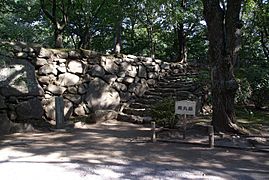Komoro Castle
| Komoro Castle | ||
|---|---|---|
|
Gate San-no-mon , outside |
||
| Creation time : | Sengoku time | |
| Castle type : | Hirayamajiro (hill castle) | |
| Conservation status: | partially preserved | |
| Place: | Komoro | |
| Geographical location | 36 ° 19 '38.4 " N , 138 ° 25' 2.1" E | |
|
|
||
The castle Komoro ( Japanese 小諸城 , Komoro-jō ) is located in the city of Komoro , Nagano Prefecture . In the Edo period , smaller Fudai daimyo resided there from 1624 .
Lords of the castle in the Edo period
- From 1590 the Sengoku with an income of 50,000 Koku .
- From 1622 Tokugawa Tadanaga (1606–1634), son of Hidetada .
- From 1624 a branch of the Hisamatsu-Matsudaira with 45,000 koku.
- From 1648 a branch of the Aoyama with 42,000 Koku.
- From 1662 a branch of the Sakai with 30,000 Koku.
- From 1679 a branch of the Nishio with 25,000 Koku.
- From 1682 a branch of the Ishikawa with 20,000 koku.
- From 1702 a branch of Makino with 15,000 koku.
history
The origin of Komoro Castle is not certain, but at the latest at the end of the Sengoku period , a fortification was built by Takeda Shingen . After that, Oda Nobunaga , the later Hōjō and Tokugawa Ieyasu had the castle in their possession. 1590 took over Sengoku Hidehisa (1552-1614), daimyo under Toyotomi Hideyoshi , the castle. Hidehisa reinforced the walls and built the three-story castle tower. In the Edo period, the Sengoku was followed by a series of Fudai daimyo.
Komoro Castle was built on a hill at the foot of the Asama volcano , despite the occasional falling ash mixed with small rocks. Grooves formed by rainwater were used for the system. Similar castles can be found in the area, this one probably got its shape at the time of the Sengoku. The castle complex included the central area with the castle tower, the Hommaru ( 本 丸 ), the Ni-nomaru ( 二 の 丸 ), which was divided into the areas Kita-no-maru (北 の 丸) and Minami-no-maru ( 南 の 丸 ) and through the gate "Third Gate" ( 三 の 門 , San-no-mon ) was secured. Below the Hommaru the “Akazu-no-mon” ( 不明 門 , literally: “The gate that cannot be opened”) led directly outside. However, the castle tower was already lost in the Kan'ei period (1624–1644) due to lightning strikes and fire and was not rebuilt. Before that there were other areas at the end of which was the main gate ( 大 手 門 , Ōte-mon ). In 1742 the third gate and other things were lost due to flooding, but the castle was restored by 1765.
Today the main part of the castle is the Kaikoen park ( 懐 古 園 ). The San-no-mon gate has been preserved in the Ni-no-maru area . The base of the castle tower, the stone walls of the Hommaru and part of the moat furrows can still be seen. The main gate, now cut off from the main part of the castle by the Shinano railway line , still exists and is surrounded by a small green area.
photos
literature
- Takada, Tōru: Komoro-jo in: Miura, Masayuki (ed.): Shiro to jin'ya. Tokoku-hen. Gakken, 2006. ISBN 978-4-05-604378-5 , p. 100.
- Nishigaya, Yasuhiro (Ed.): Komoro-jo. In: Nihon meijo zukan, Rikogaku-sha, 1993. ISBN 4-8445-3017-8 .








